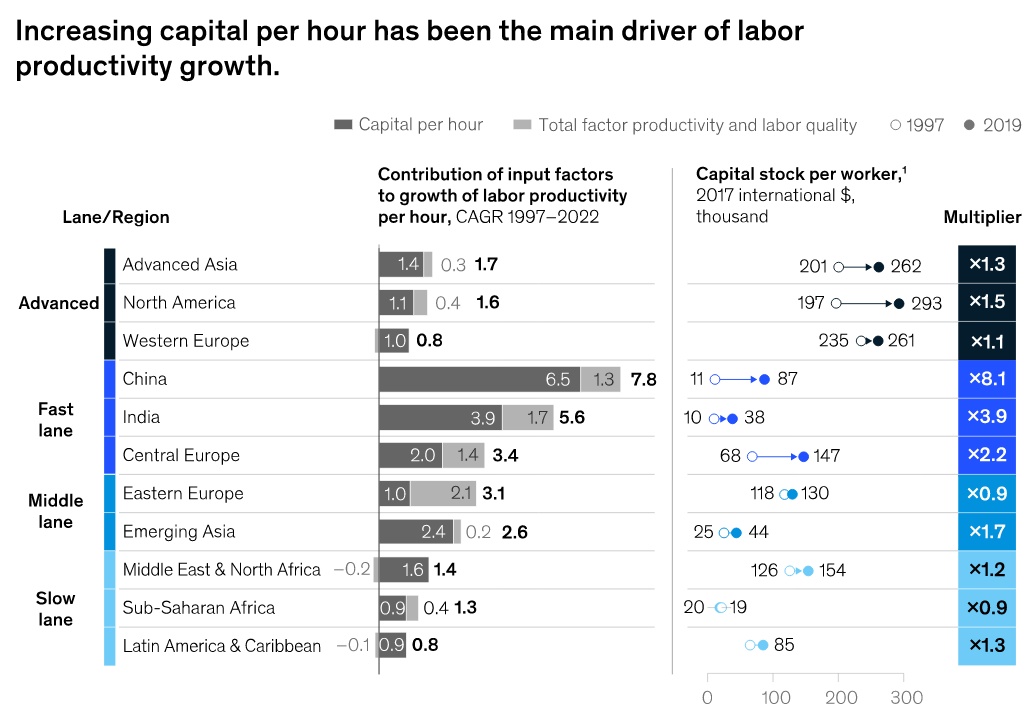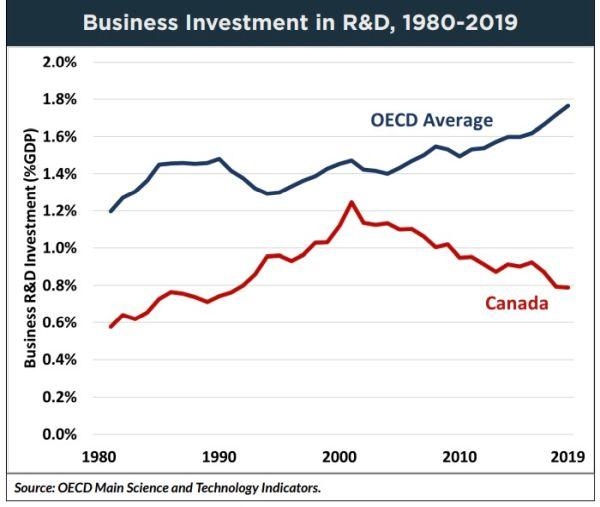Productivity | March 29, 2024

 Image: McKinsey, Investing in Productivity Growth (Exhibit 5)
Image: McKinsey, Investing in Productivity Growth (Exhibit 5)Global Productivity Grew Sixfold in 3 Decades but Advanced Economies Have Slowed
According to a McKinsey & Company analysis, the next wave of global productivity and economic growth is within reach, yet countries need to invest in productivity to harvest it or be left behind especially when faced with challenges like aging populations, the energy transition, and supply chain reconfigurations. The median economy’s productivity has surged sixfold over the past 25 years, with 30 emerging economies experiencing rapid improvements. Yet, advanced economies have seen a slowdown, with productivity growth decelerating by about one percentage point since the global financial crisis.
High investment rates, ranging from 20 to 40 percent of GDP in fast-lane economies like China and India, have supported urbanization, higher productivity in service sectors, and globally connected manufacturing.
See: Canada’s Lagging AI Adoption Needs to Accelerate to Compete
For advanced economies, regaining pre-crisis productivity growth rates could yield an incremental GDP per capita increase of $1,500 to $8,000 by 2030. Directed investments in digitization, automation, and artificial intelligence could reignite productivity growth.
Harnessing the Next Wave of Productivity Growth Should Be Canada’s Top Priority

 Image: OECD, Business Investment Canada vs OECD Average 1980-2019
Image: OECD, Business Investment Canada vs OECD Average 1980-2019Canada’s productivity landscape is currently facing significant challenges and opportunities for improvement. According to a detailed analysis by the Bank of Canada, several key factors are identified as crucial for enhancing the nation’s productivity:
For Canada to drive greater innovation and efficiency, especially among small and medium-sized enterprises (SMEs), a more competitive business landscape is essential. SMEs often lack the economies of scale that benefit larger companies, making it crucial to foster an environment that supports their growth and innovation capabilities. Many innovation groups and experts have talked about Canada’s lack of business investment and outdated policies for moderns times in a knowledge-based economy where intangible assets require investing in intellectual property ownership to capture value at scale.
See: C.D.Howe Report: Canada’s Weak Business Investment Threatens Prosperity
One of the most critical areas of concern is Canada’s investment levels in machinery, equipment, and intellectual property. Over the past decade, investment levels have not only been insufficient but have also seen a decline. Boosting investment in these vital areas is imperative for enhancing productivity and, consequently, economic growth and wages without resorting to high inflation.
Ways to Boost Canada’s Lagging Productivity
- The adoption of digital technologies, artificial intelligence (AI), and automation has significantly increased productivity in various sectors by optimizing operations, reducing errors, and enabling innovation. “Canadian’s need to take more risks”
- Education and continuous skill development tailored to the evolving job market demands ensure that the workforce remains competitive, adaptable, and productive. This requires investing in human capital.
- Investments in infrastructure development, including transportation, digital connectivity, and utilities, facilitate smoother operations for businesses and contribute to economic efficiency.
See: CIC Launch Delayed Impacting Innovation Funding Landscape
- A strong focus on research and development (R&D) across industries fosters innovation, leading to new products, services, and processes that drive productivity growth. Investing in new technologies and education can avoid outdated practices, inefficiencies, and a workforce that is not equipped with the necessary skills for modern challenges. While technology can greatly enhance productivity, it can also lead to displacement of workers. Without adequate retraining and transition mechanisms, this can temporarily reduce productivity as sectors adjust to new technologies.
- Open trade policies and globalization have historically contributed to productivity growth by optimizing supply chains, enabling access to larger markets, and fostering competition and innovation.
- Avoid Regulatory and Bureaucratic Inefficiencies. Overly complex regulations and bureaucratic processes can hinder business operations, slow down innovation, and deter investment, negatively impacting productivity.
- Income Inequality and Access to Opportunities. Significant disparities in income and access to education and technology can limit productivity growth by not fully utilizing the potential of the entire population.
A few links you make like:
These insights and trends highlight the complex interplay of factors that influence productivity. Addressing the challenges while leveraging the positive trends requires coordinated policy efforts, strategic investments, and a focus on inclusive growth that ensures the benefits of increased productivity are widely shared.
Conclusion
Global productivity has seen remarkable growth, yet advanced economies are experiencing a slowdown. Directing investments towards digitization, automation, artificial intelligence, and crucially, human capital, nations can reignite productivity growth. For Canada, addressing its lagging productivity through increased investment in new technologies, machinery, and intellectual property, alongside fostering a competitive business landscape and reducing regulatory inefficiencies, is not just an economic necessity for sustainable growth and living standards.

 The National Crowdfunding & Fintech Association (NCFA Canada) is a financial innovation ecosystem that provides education, market intelligence, industry stewardship, networking and funding opportunities and services to thousands of community members and works closely with industry, government, partners and affiliates to create a vibrant and innovative fintech and funding industry in Canada. Decentralized and distributed, NCFA is engaged with global stakeholders and helps incubate projects and investment in fintech, alternative finance, crowdfunding, peer-to-peer finance, payments, digital assets and tokens, artificial intelligence, blockchain, cryptocurrency, regtech, and insurtech sectors. Join Canada’s Fintech & Funding Community today FREE! Or become a contributing member and get perks. For more information, please visit: www.ncfacanada.org
The National Crowdfunding & Fintech Association (NCFA Canada) is a financial innovation ecosystem that provides education, market intelligence, industry stewardship, networking and funding opportunities and services to thousands of community members and works closely with industry, government, partners and affiliates to create a vibrant and innovative fintech and funding industry in Canada. Decentralized and distributed, NCFA is engaged with global stakeholders and helps incubate projects and investment in fintech, alternative finance, crowdfunding, peer-to-peer finance, payments, digital assets and tokens, artificial intelligence, blockchain, cryptocurrency, regtech, and insurtech sectors. Join Canada’s Fintech & Funding Community today FREE! Or become a contributing member and get perks. For more information, please visit: www.ncfacanada.org
Related Posts
- SEO Powered Content & PR Distribution. Get Amplified Today.
- PlatoData.Network Vertical Generative Ai. Empower Yourself. Access Here.
- PlatoAiStream. Web3 Intelligence. Knowledge Amplified. Access Here.
- PlatoESG. Carbon, CleanTech, Energy, Environment, Solar, Waste Management. Access Here.
- PlatoHealth. Biotech and Clinical Trials Intelligence. Access Here.
- Source: https://ncfacanada.org/can-canada-harvest-the-next-wave-of-productivity-growth/



